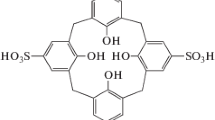Abstract
The enantiomeric isomers of organic compounds usually appear in the racemic form in synthetic reactions of the laboratory. However, each of the isomers must somehow be differentiated from the others in biosynthetic reactions, such as of proteins. This differentiation is possible in a bio-reaction because of a salt concentration of about 0.1 mol/ 1 NaCl and the presence of oxygen in the aqueous media of the reaction. Under these conditions, a magnetic field will differentiate the enantiomeric isomers. Experimental evidence shows that the above concentration is unique because it produces a kind of border for water structures. Also, amino acids interact differently with water due to differing hydrophilic properties. Finally, a salt solution of this concentration, together with oxygen, allows differentiation of the enantiomeric isomers of amino acids under a magnetic field. The results of this investigation suggest that the condition of the solution produces circumstances where each of the solute entities can be free from inter-solute interactions. This circumstance locates each solute entity in a fractional part of the solution which is equal to the quotient of the total volume of the solution divided by the total number of the solute ions. In this situation, all solutes are assumed to not interact, and accordingly, the characteristics of the solute can be distinguished. This fractional part of the solution has been termed the “molecular space”. To determine what would happen when the enantiomeric isomers of amino acids were placed in a molecular space, nuclear magnetic resonance (NMR) and differential scanning calorimetry (DSC) measurements were taken in aqueous sodium chloride solutions (about 0.1 mol/1 NaCl) which held the enantiomeric isomers of amino acids. The results showed that the D-isomers form association with oxygen under magnetic field and the L-ones not. This suggests that the D-isomers are retained in the solution by complex formation with oxygen and only the L-ones can participate to the biosynthesis under the earth’s magnetic field. The presence of oxygen and a magnetic field applied to the isomers are the factors which allow the differentiation between the l- and the D-isomers.
Similar content being viewed by others
References
A. Shimoyama, K. Harada and K. Yanai, Chem. Lett., 1985, 83.
A. Shimoyama and K. Harada, Viva Origino, 13, 13 (1985).
S. Fujiwara and Y. Nishimoto, Anal. Sci., 6, 771 (1990).
S. Fujiwara and Y. Nishimoto, Anal Sci., 7, 683 (1991).
S. Fujiwara and Y. Nishimoto, Anal. Sci., 6, 907 (1990).
S. Fujiwara and Y. Nishimoto, Anal. Sci., 7, 687 (1991).
V. B. Parker, Natl. Std. Ref. Data Ser., 2 (1965).
S. Fujiwara, Geochem. J., 13, 225 (1979).
S. Fujiwara, Anal. Sci., 4, 123 (1979).
J. P. Limutrakul, S. Fujiwara and B. M. Rode, Anal. Sci., 1, 29 (1985).
S. Fujiwara and Y. Nishimoto, Proc. Japan Academy, 59B, 333 (1985).
S. Fujiwara, Y. Nishimoto and F. Arakawa, Anal. Sci., 1, 23 (1987).
S. Fujiwara, F. Arakawa and O. Toi, Anal. Sci., 3, 213 (1987).
S. Fujiwara and S. Hayashi, J. Chem. Phys., 43, 23 (1965).
S. Fujiwara, K. Nagashima, H. Morita and Y. Kanaoka, Bull. Chem. Soc. Jpn., 50, 2851 (1977).
S. Fujiwara, S. Katsumataand T. Seki, J. Phys. Chem., 71, 115 (1967).
T. Watanabe, T. Yahagi and S. Fujiwara, J. Am. Chem. Soc, 102, 5187 (1980).
N. Murase, K. Gonda and T. Watanabe, J. Phys. Chem., 102, 5187 (1980).
N. Murase and T. Watanabe, Mag. Res. Med, 9, 1 (1989).
M. Takeda and O. Jardetzky, J. Chem. Phys., 26, 1345 (1989).
S. Fujiwara, Y. Arata and H. Momoi, Bull. Chem. Soc. Jpn., 35, 1658 (1962).
S. Mizushima, Y. Morino and K. Higashi, Sci. Pap. Inst. Phys. Chem. Res., 25, 159 (1934).
S. Fujiwara and Y. Arata, Bull. Chem. Soc. Jpn., 36, 578 (1963).
S. Fujiwara and Y. Arata, Bull. Chem. Soc. Jpn., 37, 344 (1964).
H. Ogura, Y. Arata and S. Fujiwara, J. Mol. Spec, 23, 76 (1967).
H. Ishizuka, T. Yamamoto, Y. Arata and S. Fujiwara, Bull. Chem. Soc. Jpn., 45, 468 (1973).
T. Fukuroi, Y. Fujiwara, S. Fujiwara and K. Fujii, Anal Chem., 40, 879 (1968).
“Gmelins Handbuch der Anorganischen Chemie”, 8 Auf. System Nr. 221, S. 332 (1928).
S. Fujiwara and Y. Nishimoto, Anal. Sci., in press.
S. Fujiwara and Y. Nishimoto, Anal. Sci., in press.
F. Franks ed., “Water”, Vol. 1, p. 172, Plenum Press, New York, 1972.
W. Chazin, J. Kordel, E. Thulin, T. Hofmann, T. Grackenberg and S. Forsen, Biochemistry, 28, 8646 (1989).
E. R. Stadtman, J. Gerontology, 43, B112 (1988).
R. Shapira, G. E. Austin and S. S. Mirra, J. Neurochem., 50, 69 (1988).
R. Shapira, K. D. Wilkinson and G. Shapira, J. Neurochem., 50, 649 (1988).
N. Fujii, S. Muraoka and K. Harada, Biochem. Biophys. Acta, 999, 239 (1989).
For example, F. Franks ed., “Water”, Vol. 1, p. 117, Plenum Press, New York, 1972 and Vol. 7, p. 69, dy1983.
S. Fujiwara, H. Haraguchi and Y. Umezawa, Anal. Chem., 40, 249 (1968).
S. Fujiwara, Y. Umezawa and T. Kugo, Anal Chem., 40, 186 (1968).
The surface of the biomernbrane has been referred to as a cell of thickness of 0.5–5 nm (A. Ehrenberg, Proceeding of seminor, IVA meddelande 187, Stockholm 1976, p. 134). The said cell may correspond to the molecular space cited in this article.
Author information
Authors and Affiliations
Rights and permissions
About this article
Cite this article
Fujiwara, S. Analytico- Chemical Evidence for Differentiation of Amino Acid Enantiomers in Aqueous Solutions of Physiological Salinity. ANAL. SCI. 8, 589–597 (1992). https://doi.org/10.2116/analsci.8.589
Received:
Accepted:
Published:
Issue Date:
DOI: https://doi.org/10.2116/analsci.8.589




